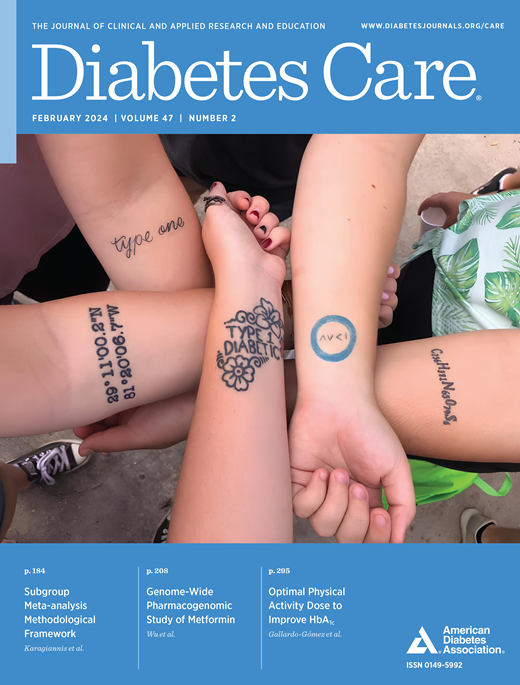注射器和针头重复使用对 2 型糖尿病患者临床疗效的影响:为期 12 周的随机临床试验
IF 14.8
1区 医学
Q1 ENDOCRINOLOGY & METABOLISM
引用次数: 0
摘要
目的 通过比较不重复使用或重复使用注射器和针头注射胰岛素,评估 2 型糖尿病患者的临床和实验室结果。研究设计和方法 随机指导至少重复使用过三次注射器和针头的 2 型糖尿病成人患者不重复使用或重复使用胰岛素注射器和针头五次。评估的主要结果包括基线和干预后 4、8 和 12 周的血糖控制、疼痛评分和皮肤并发症(瘀斑、脂肪肥厚、结节、感染)。次要结果包括治疗依从性、生活质量、注射器和针头的微生物污染、针头质量和胰岛素注射技术。结果 71 名参与者(平均年龄为 59.7±8.8 岁,±标准差)中,59% 为女性,糖尿病病程中位数为 18 年(四分位数间距为 10-25 年),平均体重指数为 31.7±6.7 kg/m2。重复使用注射器和针头组的脂肪肥厚/结节增加(0.16 ± 0.08,P = 0.040),但疼痛或血糖控制并未恶化,即使注射器和针头费力地插入皮肤也是如此。两组在皮肤并发症总数、生活质量或微生物污染方面均无差异。两组患者的治疗依从性都有所提高,重复使用组的依从性提高幅度更大。结论 重复使用注射器和针头与脂肪肥厚/结节的适度增加有关,但不会对 2 型糖尿病患者的血糖控制产生短期影响。本文章由计算机程序翻译,如有差异,请以英文原文为准。
Impact of Syringe and Needle Reuse on the Clinical Outcomes of Patients With Type 2 Diabetes: A 12-Week Randomized Clinical Trial
OBJECTIVE To evaluate the clinical and laboratory outcomes of patients with type 2 diabetes by comparing the no reuse or reuse of syringes and needles for insulin injection. RESEARCH DESIGN AND METHODS Adults with type 2 diabetes who had reused syringes and needles at least three times were randomly instructed either to not reuse or to reuse insulin syringes and needles five times. The primary outcomes assessed were glycemic control, pain scores, and skin complications (ecchymosis, lipohypertrophy, nodules, infection) at baseline and 4, 8, and 12 weeks after the intervention. Secondary outcomes included treatment adherence, quality of life, microbiological contamination of syringes and needles, needle quality, and insulin injection technique. RESULTS Among the 71 participants (mean ± SD age 59.7 ± 8.8 years), 59% were women with a median duration of diabetes of 18 years (interquartile range 10–25 years) and a mean BMI of 31.7 ± 6.7 kg/m2. The group that reused syringes and needles experienced an increase in lipohypertrophy/nodules (0.16 ± 0.08, P = 0.040) but did not experience worsening pain or glycemic control, even when the syringes and needles were inserted into the skin with great effort. There was no difference in the total number of skin complications, quality of life, or microbiological contamination. Both groups improved treatment adherence, with a greater increase in the reuse group. CONCLUSIONS The reuse of syringes and needles is associated with a modest increase in lipohypertrophy/nodules but does not have a short-term impact on glycemic control in patients with type 2 diabetes.
求助全文
通过发布文献求助,成功后即可免费获取论文全文。
去求助
来源期刊

Diabetes Care
医学-内分泌学与代谢
CiteScore
27.80
自引率
4.90%
发文量
449
审稿时长
1 months
期刊介绍:
The journal's overarching mission can be captured by the simple word "Care," reflecting its commitment to enhancing patient well-being. Diabetes Care aims to support better patient care by addressing the comprehensive needs of healthcare professionals dedicated to managing diabetes.
Diabetes Care serves as a valuable resource for healthcare practitioners, aiming to advance knowledge, foster research, and improve diabetes management. The journal publishes original research across various categories, including Clinical Care, Education, Nutrition, Psychosocial Research, Epidemiology, Health Services Research, Emerging Treatments and Technologies, Pathophysiology, Complications, and Cardiovascular and Metabolic Risk. Additionally, Diabetes Care features ADA statements, consensus reports, review articles, letters to the editor, and health/medical news, appealing to a diverse audience of physicians, researchers, psychologists, educators, and other healthcare professionals.
 求助内容:
求助内容: 应助结果提醒方式:
应助结果提醒方式:


